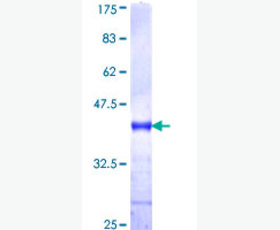Recombinant Human OX40/TNFRSF4/CD134
| Product name: | Recombinant Human OX40/TNFRSF4/CD134 |
| Source: | Human Cells |
| Purity: | Greater than 95% as determined by reducing SDS-PAGE. |
| Buffer Formulation: | Lyophilized from a 0.2 μm filtered solution of PBS, pH7.4. |
| Applications: | Applications:SDS-PAGE; WB; ELISA; IP. |
| Storage: | Avoid repeated freeze/thaw cycles. Store at 2-8 oC for one month. Aliquot and store at -80 oC for 12 months. |
| UOM: | 100ug/50ug/200ug/1mg/1g |
| Source | Human Cells |
| Description | Recombinant Human OX40 is produced by our Mammalian expression system and the target gene encoding Leu29-Ala216 is expressed with a 6His tag at the C-terminus. |
| Names | Tumor necrosis factor receptor superfamily member 4,TNFRSF4,OX40,CD134,Txgp1, REF: C1132 |
| Accession # | P43489 |
| Formulation | Lyophilized from a 0.2 μm filtered solution of PBS, pH7.4. |
| Shipping |
The product is shipped at ambient temperature. |
| Reconstitution |
Always centrifuge tubes before opening. Do not mix by vortex or pipetting. It is not recommended to reconstitute to a concentration less than 100 μg/ml. Dissolve the lyophilized protein in ddH2O. Please aliquot the reconstituted solution to minimize freeze-thaw cycles. |
| Storage |
Lyophilized protein should be stored at < -20°C, though stable at room temperature for 3 weeks. Reconstituted protein solution can be stored at 4-7°C for 2-7 days. Aliquots of reconstituted samples are stable at < -20°C for 3 months. |
| Purity |
Greater than 95% as determined by reducing SDS-PAGE. |
| Endotoxin | Less than 0.1 ng/µg (1 IEU/µg) as determined by LAL test. |
| Amino Acid Sequence |
LHCVGDTYPSNDRCCHECRPGNGMVSRCSRSQNTVCRPCGPGFYNDVVSSKPCKPCTWCNLRSGS ERKQLCTATQDTVCRCRAGTQPLDSYKPGVDCAPCPPGHFSPGDNQACKPWTNCTLAGKHTLQPA SNSSDAICEDRDPPATQPQETQGPPARPITVQPTEAWPRTSQGPSTRPVEVPGGRAVAHHHHHH
|
| Background | OX40, also termed CD134 and TNFRSF4, is a T cell co-stimulatory molecule of the TNF receptor superfamily which plays a key role in the survival and homeostasis of effector and memory T cells. OX40 is expressed on CD4+ and CD8+ T cells upon engagement of the TCR by antigen presenting cells along with co-stimulation by CD40-CD40 Ligand and CD28-B7. The interaction between OX40 and OX40 ligand (OX40L) will occur when activated T cells bind to professional antigen-presenting cells (APCs). The T-cell functions, including cytokine production, expansion, and survival, are then enhanced by the OX40 costimulatory signals. OX40 signals are critical for controlling the function and differentiation of Foxp3+ regulatory T cells. OX40-OX40L interaction regulates T-cell tolerance, peripheral T-cell homeostasis, and T-cell-mediated inflammatory diseases. |














